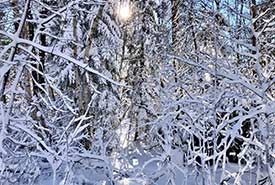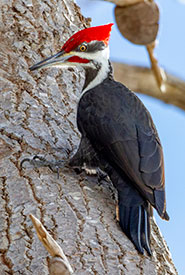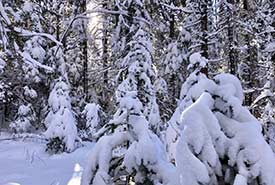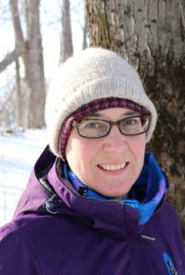Pics, or it didn't happen

A snow covered forest (Photo by Paula Noel/NCC staff)
The day after our first real snowstorm of the winter, I headed out to enjoy the woods near my home. At a brisk -10 C, it was the perfect temperature for hiking with the right gear on, but not an ideal temperature for my cell phone; I couldn’t resist taking too many photos of the marshmallow-y forest, and my phone’s battery quickly died.
The woods were eerily quiet with the thick snow, so my attention was quickly drawn to a sound on my left. I saw a flash of red as a large bird settled on a snag (a dead, standing tree) just a couple metres away: a pileated woodpecker! The bird seemed to notice me at the same time, but I crouched down and held very still. Apparently, I was not deemed a threat as it ignored me and got down to work.

Pileated woodpecker (Photo by Denis Doucet, CC BY-NC 4.0)
Starting near an existing hole in the trunk, it chipped chunks of wood off with its powerful beak. Then it paused and leaned its head to the side in a gesture so familiar to humans that I immediately knew it was listening intently. I recalled reading that woodpeckers can actually hear bugs moving inside the wood of a tree. It continued, repeating this behaviour again and again, either finding tasty treats or determined to keep searching.
I marvelled at how close I was and despaired that if my phone hadn’t died, I could get a great picture! Pileated woodpeckers are the largest woodpecker in North America and are found in every province except Newfoundland and Labrador. They don’t migrate so you can find them in the same area year-round. They prefer mature forests and excavate large rectangular holes in dead and dying trees. Many other birds use these cavities as nesting sites.
“Pics, or it didn’t happen” is a common expression on social media. It started as a response to outlandish claims but has evolved to be used frequently on any posts that don’t include images. While social media can provide entertainment and connection, there are also benefits to unplugging from time to time. Increasing screen time and frequent use of social media have been linked to anxiety, depression and other mental health challenges.

Marshmallow-y snow on tree branches (Photo by Paula Noel/NCC staff)
One way to counter these impacts is to spend more time in nature. Research has shown that time in nature, even walking through a city park, can boost our mood, lower our stress and improve our sense of connection. And, as I sometimes need to remind myself, time in nature doesn’t always need to be documented and curated for our social media profiles. As I watched this beautiful creature go about finding food, completely ignoring me, I was happy to be just enjoying the moment in the silent, snow-covered woods. I didn’t need a picture to remember that it happened.


